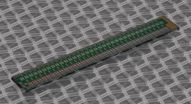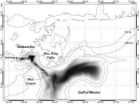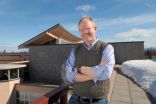(Press-News.org) DALLAS, March 18, 2014 — When a heart gets damaged, such as during a major heart attack, there's no easy fix. But scientists working on a way to repair the vital organ have now engineered tissue that closely mimics natural heart muscle that beats, not only in a lab dish but also when implanted into animals. They presented their latest results at the 247th National Meeting & Exposition of the American Chemical Society (ACS), the world's largest scientific society.
The talk was one of more than 10,000 being presented at the meeting, which continues here through Thursday.
"Repairing damaged hearts could help millions of people around the world live longer, healthier lives," said Nasim Annabi, Ph.D. Right now, the best treatment option for patients with major heart damage — which can be caused by severe heart failure, for example — is an organ transplant. But there are far more patients on waitlists for a transplant than there are donated hearts. Even if a patient receives a new heart, complications can arise.
The ideal solution would be to somehow repair the tissue, which can get damaged over time when arteries are clogged and starve a part of the heart of oxygen. Scientists have been searching for years for the best fix. The quest has been confounded by a number of factors that come into play when designing a complex organ or tissue.
Simple applications, such as engineered skin, are already in use or in clinical trials. But building tissue for an organ as complicated as the heart requires a lot more research. To address this challenge and engineer complex 3-D tissues, researchers at the Brigham and Women's Hospital and Harvard Medical School in Boston and the University of Sydney in Australia were able to combine a novel elastic hydrogel with microscale technologies to create an artificial cardiac tissue that mimics the mechanical and biological properties of the native heart.
"Our hearts are more than just a pile of cells," said Ali Khademhosseini, Ph.D., who is at Harvard Medical School. "They're very organized in their architecture."
To tackle the challenge of engineering heart muscle, Khademhosseini and Annabi have been working with natural proteins that form gelatin-like materials called hydrogels.
"The reason we like these materials is because in many ways they mimic aspects of our own body's matrix," Khademhosseini said. They're soft and contain a lot of water, like many human tissues.
His group has found that they can tune these hydrogels to have the chemical, biological, mechanical and electrical properties they want for the regeneration of various tissues in the body. But there was one way in which the materials didn't resemble human tissue. Like gelatin, early versions of the hydrogels would fall apart, whereas human hearts are elastic. The elasticity of the heart tissue plays a key role for the proper function of heart muscles such as contractile activity during beating. So, the researchers developed a new family of gels using a stretchy human protein aptly called tropoelastin. That did the trick, giving the materials much needed resilience and strength.
But building tissue is not just about developing the right materials. Making the right hydrogels is only the first step. They serve as the tissue scaffold. On it, the researchers grow actual heart cells. To make sure the cells form the right structure, Khademhosseini's lab uses 3-D printing and microengineering techniques to create patterns in the gels. These patterns coax the cells to grow the way the researchers want them to. The result: small patches of heart muscle cells neatly lined up that beat in synchrony within the grooves formed on these elastic substrates. These micropatterned elastic hydrogels can one day be used as cardiac patches. Khademhosseini's group is now moving into tests with large animals. They are also using these elastic natural hydrogels for the regeneration of other tissues such as blood vessels, skeletal muscle, heart valves and vascularized skin.
INFORMATION:
A press conference on this topic will be held Tuesday, March 18, at 3:30 p.m. Central time in Room A122/A123 of the Dallas Convention Center. Reporters can attend in person or access live video of the event and ask questions at the ACS Ustream channel http://www.ustream.tv/channel/acslive.
Khademhosseini acknowledges funding from the National Institutes of Health, the National Science Foundation and the U.S. Department of Defense.
The American Chemical Society is a nonprofit organization chartered by the U.S. Congress. With more than 161,000 members, ACS is the world's largest scientific society and a global leader in providing access to chemistry-related research through its multiple databases, peer-reviewed journals and scientific conferences. Its main offices are in Washington, D.C., and Columbus, Ohio.
To automatically receive news releases from the American Chemical Society, contact newsroom@acs.org.
Note to journalists: Please report that this research was presented at a meeting of the American Chemical Society.
Follow us: Twitter | Facebook
Title
Microengineered hydrogels for stem cell bioengineering and tissue regeneration
Abstract
Micro- and nanoscale technologies are emerging as powerful tools for controlling the interaction between cells and their surroundings for biological studies, tissue engineering, and cell-based screening. In addition, hydrogel biomaterials have been increasingly used in various tissue engineering applications since they provide cells with a hydrated 3D microenvironment that mimics the native extracellular matrix. In our lab we have developed various approaches to merge microscale techniques with hydrogel biomaterials for directing stem cell differentiation and generating complex 3D tissues. In this talk, I will outline our work in controlling the cell-microenvironment interactions by using patterned hydrogels to direct the differentiation of stem cells. In addition, I will describe the fabrication and the use of microscale hydrogels for tissue engineering by using a 'bottom-up' and a 'top-down' approach. Top-down approaches for fabricating complex engineered tissues involve the use of miniaturization techniques to control cell-cell interactions or to recreate biomimetic microvascular networks. Our group has also pioneered bottom-up approaches to generate tissues by the assembly of shape-controlled cell-laden microgels (i.e. tissue building blocks), that resemble functional tissue units. In this approach, microgels were fabricated and induced to self assemble to generate 3D tissue structures with controlled microarchitecture and cell-cell interactions.
Building heart tissue that beats
2014-03-18
ELSE PRESS RELEASES FROM THIS DATE:
Bees capable of learning feats with tasty prize in sight
2014-03-18
They may have tiny brains, but bumblebees are capable of some remarkable learning feats, especially when they might get a tasty reward, according to two studies by University of Guelph researchers.
PhD student Hamida Mirwan and Prof. Peter Kevan, School of Environmental Sciences, are studying bees' ability to learn by themselves and from each other.
In the first study, published in February in Animal Cognition, the researchers found bees capable of learning to solve increasingly complex problems.
The researchers presented bees with a series of artificial flowers that ...
Sauder research shows why innovation takes a nosedive
2014-03-18
A new UBC study reveals that corporate leaders are victims of herd mentality when adopting new innovations, sometimes with deadly consequences.
The paper, by Sauder School of Business Associate Professor Marc-David L. Seidel and INSEAD Professor Henrich R. Greve, shows leaders tend to pursue innovations, even as complex as airplanes, based on early adoption by competitors not close scrutiny of the technical merits.
"Business leaders tend to panic when new innovations are about to hit the market. They scramble to buy an apparent early leader," says Seidel. "Sometimes ...
Stanford researchers survey protein family that helps the brain form synapses
2014-03-18
Neuroscientists and bioengineers at Stanford are working together to solve a mystery: how does nature construct the different types of synapses that connect neurons -- the brain cells that monitor nerve impulses, control muscles and form thoughts.
In a paper published in the Proceedings of the National Academy of Sciences, Thomas C. Südhof, M.D., a professor of molecular and cellular physiology, and Stephen R. Quake, a professor of bioengineering, describe the diversity of the neurexin family of proteins.
Neurexins help to create the synapses that connect neurons. Think ...
TGen-led study spotlights dog DNA role in developing new therapies for human cancers
2014-03-18
PHOENIX, Ariz. — March 17, 2014 — Using genomic analysis to study cancer in dogs can help develop new therapies for humans with cancer, according to a proof-of-concept study led by the National Cancer Institute (NCI) and the Translational Genomics Research Institute (TGen).
Pure-breed dogs, whose genetics have been standardized by hundreds of years of human intervention, provide highly predictable genetic models useful in designing clinical trials, in which specific drugs are matched to the molecular profiles of human patients, according to the study published today in ...
Kessler Foundation researchers link body temperature to relapsing-remitting MS and fatigue
2014-03-18
West Orange, NJ. March 18, 2014. Kessler Foundation researchers have demonstrated for the first time ever that body temperature is elevated endogenously in relapsing-remitting multiple sclerosis (RRMS) and linked to worse fatigue. The article was published ahead of print on Feb. 21, 2014 in Archives of Physical Medicine & Rehabilitation. Sumowski J, Leavitt V: Body temperature is elevated and linked to fatigue in relapsing-remitting multiple sclerosis, even without heat exposure. doi:10.1016/j.apmr.2014.02.004.
Researchers measured body temperature in 50 patients with ...
NIST chips help BICEP2 telescope find direct evidence of origin of the universe
2014-03-18
The view back in time—way back to the origins of the universe—just got clearer. Much clearer.
A team of U.S. cosmologists using the BICEP2 telescope at the South Pole announced this week that they have discovered the first direct evidence of the rapid inflation of the universe at the dawn of time, thanks in part to technology developed and built by the National Institute of Standards and Technology (NIST).
The BICEP2 camera relies, in part, on the extraordinary signal amplification made possible by NIST's superconducting quantum interference devices (SQUIDs).
The ...
NRL models Deepwater Horizon oil spill
2014-03-18
Dr. Jason Jolliff is an oceanographer with the U.S. Naval Research Laboratory (NRL). "The emphasis here," he says, "is on developing models of the ocean environment to help the naval warfighter." His most recent paper, published in Ocean Modeling (March 2014), shows NRL can also forecast where oil will go following a major spill.
"If you're going to do forecasting," he says, "you have to get the ocean circulation correct. It's fundamental to all else." Jolliff plugged the distribution of surface oil following the 2010 Deepwater Horizon oil spill—when it was still well ...
Canadian drinking-age laws have significant effect on deaths among young males
2014-03-18
A recent study by a University of Northern British Columbia-based scientist associated with the UBC Faculty of Medicine and UNBC's Northern Medical Program demonstrates that Canada's drinking-age laws have a significant effect on youth mortality.
The study was published yesterday in the international journal Drug and Alcohol Dependence. In it, Dr. Russell Callaghan writes that when compared to Canadian males slightly younger than the minimum legal drinking age, young men who are just older than the drinking age have significant and abrupt increases in mortality, especially ...
Global food trade can alleviate water scarcity
2014-03-18
Trading food involves the trade of virtually embedded water used for production, and the amount of that water depends heavily on the climatic conditions in the production region: It takes, for instance, 2.700 liters of water to produce 1 kilo of cereals in Morocco, while the same kilo produced in Germany uses up only 520 liters. Analyzing the impact of trade on local water scarcity, our scientists found that it is not the amount of water used that counts most, but the origin of the water. While parts of India or the Middle East alleviate their water scarcity through importing ...
Using big data to identify triple-negative breast, oropharyngeal, and lung cancers
2014-03-18
Researchers at Case Western Reserve University and colleagues used "big data" analytics to predict if a patient is suffering from aggressive triple-negative breast cancer, slower-moving cancers or non-cancerous lesions with 95 percent accuracy.
If the tiny patterns they found in magnetic resonance images prove consistent in further studies, the technique may enable doctors to use an MRI scan to diagnose more aggressive cancers earlier and fast track these patients for therapy. Their work is published online in the journal Radiology at http://pubs.rsna.org/doi/full/10.1148/radiol.14131384. ...





